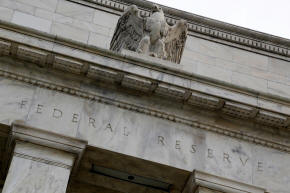Column-Cruel to be kind - Fed seems tempted by 1994 playbook :Mike Dolan
 Send a link to a friend
Send a link to a friend
 [March 23, 2022] By
Mike Dolan [March 23, 2022] By
Mike Dolan
LONDON (Reuters) - Tighten hard and fast
now and you might just avoid triggering recession - it seems the Federal
Reserve is tempted by its own playbook from almost 30 years ago.
In just 12 months from February 1994, the Fed doubled its main policy
rate to 6% in seven rapid-fire hikes that included two 50 basis point
moves and a swingeing 75bp rise for good measure.
Although it whacked the bond market - and some argue sowed the seeds of
serial emerging market crises over the remainder of the decade - the
Fed's short, sharp shock avoided an inversion of the 2-to-10 year
Treasury yield curve, which is for many the most reliable harbinger of
recession ahead.
True to the predictive power of the yield curve, a U.S. recession was
averted and the Fed succeeded in achieving a rare 'soft landing' for the
economy.
Faced with distortions from a global pandemic and energy price shock due
to war in Ukraine, history may not be a great guide to anything right
now. Much has changed in the economy, bond markets and banking system
over three decades.
But it might still be useful in figuring out the Fed's reaction
function.

"Eat your heart out, 1994," reckoned Morgan Stanley strategists at the
weekend.
The U.S. central bank began its latest tightening cycle last week with a
quarter point rate rise from near zero pandemic settings. But facing
40-year high annual inflation rates close to 8%, its policymakers
predicted rates may have to go well into so-called 'restrictive'
territory above what it considers a 'neutral' 2.4% over the next two
years.
Markets scrambled again to re-price the latest hawkish twist and then
Fed chief Jerome Powell on Monday underlined this new-found 'whatever it
takes' approach to taming inflation by insisting the Fed would consider
50bp rate rises ahead if it felt necessary.
So much so that futures markets now see the Fed adding 200bp more of
tightening over its six remaining policy meetings of the year and pencil
in a 'terminal', or peak, rate both higher and sooner than previously
thought - near 3% by June of next year compared with a combination of
2.5% by September 2023 last week.
Fed watchers too have rushed to recalibrate the scale of forecast Fed
hikes ahead. Goldman Sachs economists now expect two 50 bp hikes at each
at its May and June meetings.
So far, so 1994. But how about the yield curve?
Having been crushed by a whopping 140 bp over the past year - and even
as other parts of the curve have tipped negative - the pivotal gap
between 2 and 10 year Treasury bond yields remains just positive - even
if it's now teetering less than 20 bps from a portentous inversion.

For the record, that gap got as low as 7bp in December 1994 - just after
the mega 75bp Fed thunderbolt - but it never turned negative.
Crude comparisons would suggest that this time around we may be in for a
long, nervy wait on the brink even if the alarm bells around world
markets are to stay silent.
Graphic: Fed cycles, the yield curve and recessions:
https://fingfx.thomsonreuters.com/
gfx/mkt/gkplgqgkxvb/One.PNG
Graphic: The Squeeze Is On?:
https://fingfx.thomsonreuters.com
/gfx/mkt/gdpzyjyanvw/Two.PNG
[to top of second column] |

An eagle tops the U.S. Federal Reserve building's facade in
Washington, July 31, 2013. REUTERS/Jonathan Ernst

NARROW 'SOFT LANDING' STRIP
Deutsche Bank and others have spotlighted recently just how narrow the 'soft
landing' strip ahead is for the Fed, showing how delicate the balancing act will
be in touching down without crashing.
Both the Fed and the markets now agree that policy rates will have to move at
least half a percentage point above the 2.4% estimate of 'neutral', deliberately
cooling the economy to below long-term potential growth estimates of 1.8% and
dragging inflation back down to its 2-percent target eventually.
But, as Morgan Stanley's team point out, that involves effectively halving
growth from here and then tapping and nudging the controls to stop momentum
pushing it over the edge.
"Any such deceleration has to raise materially the probability of a recession,
even if a recession is not the base case — which it is not for us," it told
clients.
The U.S. bank expects the 2-10 yield curve to invert this time around - ending
the year at a negative 35bp - but no recession to follow.
Why? One of the things it cites is the disappearance over the past decade of the
so-called 'term premia' on yields of longer-term bonds - additional compensation
that used to be demanded by investors to cover the risk of things going bump in
the night over many years holding the same bond.
Reasons for the evaporation of this term premium vary - from the impact of years
of Fed bond buying policies to almost a decade of sub-target inflation.
But without these term premia today, a normal inversion of rate curve over the
cycle that simply maps how the Fed will tighten, control inflation and then ease
again risks inverting the Treasury curve as well. In other words, there's a
possibility that inversion ain't what it used to be.

An alternative view, of course, is that the Fed is just talking tough and hoping
the market scare by itself will be enough to ensure it won't have to follow
through with the sort of aggressive moves seen in the 1990s.
Likening it to how she often tries in vain to deal with her unruly teenage kids,
Invesco strategist Kristina Hooper thinks the Fed may be warning just for effect
- "speaking loudly but hoping that big actions don't become necessary."
"Sometimes tough talk can do the trick."
The author is editor-at-large for finance and markets at Reuters News. Any views
expressed here are his own
(by Mike Dolan, Twitter: @reutersMikeD)
[© 2022 Thomson Reuters. All rights
reserved.]This material may not be published,
broadcast, rewritten or redistributed.
Thompson Reuters is solely responsible for this content.
 |